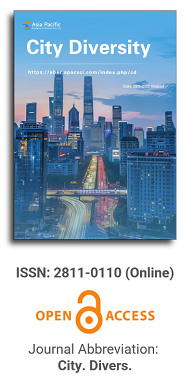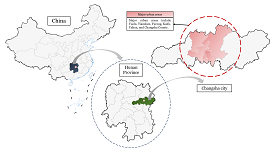
Asia Pacific Academy of Science Pte. Ltd. (APACSCI) specializes in international journal publishing. APACSCI adopts the open access publishing model and provides an important communication bridge for academic groups whose interest fields include engineering, technology, medicine, computer, mathematics, agriculture and forestry, and environment.

As China's pillar industry, the property market has suffered a considerable impact in recent years, with a decline in turnover and many developers at risk of bankruptcy. As one of the most concerned factors for stakeholders, housing prices need to be predicted more objectively and accurately to minimize decision-making errors by developers and consumers. Many prediction models in recent years have been unfriendly to consumers due to technical difficulties, high data demand, and varying factors affecting house prices in different regions. A uniform model across the country cannot capture local differences accurately, so this study compares and analyses the fitting effects of multiple machine learning models using February 2024 new building data in Changsha as an example, aiming to provide consumers with a simple and practical reference for prediction methods. The modeling exploration applies several regression techniques based on machine learning algorithms, such as Stepwise regression, Robust regression, Lasso regression, Ridge regression, Ordinary Least Squares (OLS) regression, Extreme Gradient Boosted regression (XGBoost), and Random Forest (RF) regression. These algorithms are used to construct forecasting models, and the best-performing model is selected by conducting a comparative analysis of the forecasting errors obtained between these models. The research found that machine learning is a practical approach to property price prediction, with least squares regression and Lasso regression providing relatively more convincing results.
Biodiversity and environment in cities—A case study of birds in urban and suburban areas of Japan
Vol 4, Issue 1, 2023
Download PDF
Abstract
Keywords
References
- Ministry of the Environment, Government of Japan. Annual report on the environment, the sound material-cycle, Society and the biodiversity in Japan 2010. Tokyo, Ministry of the Environment; 2010. pp. 174.
- Biodiversity Center, Nature Conservation Bureau. Biodiversity in Japan. Tokyo: Heibonsha Ltd; 2010. pp. 210.
- Environment Ministry. Conservation and sustainable use of biodiversity. In: White paper on environment, Environmental, circulatory society and biodiversity white paper. Ministry of environment; 2018. pp. 129–158
- Ministry of Environment.Report on the Joint Assessment of Biodiversity and Ecosystem. Biology Planning Room of Natural Environment Planning Course of Environment Bureau of Environment Province; 2016. pp. 157.
- Yamada H. Economic growth, urbanization and regional policy in postwar Japan. Proceedings of the Japan Society of Civil Engineers. 1994; 1994(494): 1–12. doi: 10.2208/jscej.1994.494_1
- Ministry of Land, Infrastructure and Transport. Development of green and open space policy toward new stage. Ministry of Land, Infrastructure and Transport; 2016. pp. 33.
- Biodiversity Earth Strategy Planning Office, Natural Environment Planning Division, Natural Environment Bureau, Ministry of the Environment. Consideration on disaster prevention and disaster mitigation utilizing ecosystem. Biodiversity Earth Strategy Planning Office, Natural Environment Planning Division, Natural Environment Bureau, Ministry of the Environment; 2016. pp. 63.
- Uematsu H. The corporate alliance leverages and manages the public space in Umeda area: Leveraging a public space improves worth of surroundings areas. Journal of the Japanese Institute of Landscape Architecture. 2017; 80(4): 330–331.
- Ueda T. Mori examples in Roppongi, Toranomon and Shinbashi: creating and nurturing cities. City planning review. 2014; 63(2): 60–63.
- Okuk I T. Improving shibuya, launched: community-based development through urban renaissance special district. City planning review. 2014; 63(2): 68–73.
- Forman RTT. Land Mosaic. Edinburgh: Cambridge University Press; 1995. pp .44–285.
- Ministry Of Land, Infrastructure and Transport. Current situation and issues of green policy. Ministry Of Land, Infrastructure and Transport; 2015. pp. 25.
- Fukui W. A basic study on the land use optimization from avifauna at urban fringe rural area [PhD thesis]. Osaka: Osaka Prefecture University; 1999. pp. 124.
- Biddy CJ, Burgess ND, Hill DA, et al. Bird Census Techniques. Pittsburg: Academic Press. 1997; pp. 665–104.
- Ichinose T. Relationship between the appearance of birds in urban parks and the vegetation and surrounding land uses. Journal of the City Planning Institute of Japan. 2002; 37(0): 919–924. doi: 10.11361/journalcpij.37.919
- Ichinose T. Infuence of the vegetation and surrounding land use on the bird distribution in the wintering season. Journal of the City Planning Institute of Japan. 2003; 38.3(0): 625–630. doi: 10.11361/journalcpij.38.3.625
- Katoh K, Yoshida R, Takahashi T, et al. Factors influencing avian species composition recorded in urban and suburban small wooded patches. Journal of The Japanese Institute of Landscape Architecture. 2015; 78(5): 671–676. doi: 10.5632/jila.78.671
- Katoh K, Yoshida R. Are bird communities in urban woodlands influenced by surrounding land cover? Journal of The Japanese Institute of Landscape Architecture. 2011; 74(5): 507–510. doi: 10.5632/jila.74.507
- Katoh K. Factors influencing bird occurrence in urban woods. City planning review. 2010; 59(5): 58–61.
- Blake JG, Karr JR. Breeding Birds of Isolated Woodlots: Area and Habitat Relationships. Ecology. 1987; 68(6): 1724–1734. doi: 10.2307/1939864
- Fukui W, Terashima A. A simple survey of factory greening in the Sakai-Senboku coastal industrial area based on greening and bird habitat. Journal of the Japanese Society of Revegetation Technology. 2011; 37(1): 199–202. doi: 10.7211/jjsrt.37.199
- Rüdisser J, Walde J, Tasser E, et al. Biodiversity in cultural landscapes: influence of land use intensity on bird assemblages. Landscape Ecology. 2015; 30(10): 1851–1863. doi: 10.1007/s10980-015-0215-3
- Mörtberg U, Wallentinus HG. Red-listed forest bird species in an urban environment-assessment of green space corridors. Landscape and Urban Planning. 2000; 50(4): 215–226. doi: 10.1016/S0169-2046(00)00090-6
- Sasaki T, Imanishi J, Fukui W, et al. Fine-scale characterization of bird habitat using airborne LiDAR in an urban park in Japan. Urban Forestry & Urban Greening. 2016; 17: 16–22. doi: 10.1016/j.ufug.2016.03.007
- Sasak T, Imanishi J, Fukui W, et al. Fine-scale replication and quantitative assessment of forest vertical structure using LiDAR for forest avian habitat characterization. Forest Science and Technology. 2012; 8(3): 1–9. doi: 10.1080/21580103.2012.704969
- Loman J, Von Schantz T. Birds in a Farmland—More Species in Small than in Large Habitat Island. Conservation Biology. 1991; 5(2): 176–188. doi: 10.1111/j.1523-1739.1991.tb00122.x
- Fernández-Juricic E. Can human disturbance promote nestedness? A case study with breeding birds in urban habitat fragments. Oecologia. 2002; 131(2): 269–278. doi: 10.1007/s00442-002-0883-y
- Fernández-juricice. Avian spatial segregation at edges and interiors of urban parks in Madrid, Spain. Biodiversity and Conservation. 2000; 10: 1303–1316. doi: 10.1023/A:1016614625675
- Fernández‐Juricic E. Bird community composition patterns in urban parks of Madrid: The role of age, size and isolation. Ecological Research. 2000; 15(4): 373–383. doi: 10.1046/j.1440-1703.2000.00358.x
- Buxton VL, Benson TJ. Conservation-priority grassland bird response to urban landcover and habitat fragmentation. Urban Ecosystems. 2016; 19(2): 599–613. doi: 10.1007/s11252-016-0527-3
- Grafius DR, Corstanje R, Siriwardena GM, et al. A bird’s eye view: using circuit theory to study urban landscape connectivity for birds. Landscape Ecology. 2017; 32(9): 1771–1787. doi: 10.1007/s10980-017-0548-1
- Njoroge JB, Fukui W, Moromoto Y. The habitat usage of vegetation types by avifauna community in the reclaimed site of EX PO’ 70 com memoration park. Journal of the Japanese Institute of Landscape Architecture. 2000; 63(5): 501–504. doi: 10.5632/jila.63.501
- Njoroge JB, Fukui W, Natuhara Y, et al. Controls of habitat usage by avifauna in the designed landscape of Expo’70 Park. Bulletion of the International Association for Landscape Ecology-Japan. 2000; 5(2): 66–70. doi: 10.5738/jale.5.66
- Fukui W, Morimoto Y. Secular variation of avifauna in the Expo’70 Commemorative Park. Journal of the Japanese Society of Revegetation Technology. 2016; 42(1): 175–178. doi: 10.7211/jjsrt.42.175
- Strohbach MW, Lerman SB, Warren PS. Are small greening areas enhancing bird diversity? Insights from community-driven greening projects in Boston. Landscape and Urban Planning. 2013; 114: 69–79. doi: 10.1016/j.landurbplan.2013.02.007
- Fukui W. Relationship between the birds and public parks in a northern area of Fukuoka City, Japan. In: Proceedings of the 2nd International Conference of Urban Biodiversity and Design; 2010. pp. 244.
- Fukui W. The basic research of the avifauna at city park in Fukuoka City northern region. Nishi- Nippon Junior College Bulletin of Landscape. 2009; (13): 11–18.
- Wataru F. A case study on the relationship between wintering avifauna and urban planting space in Xiamen City, Fujian, China. Journal of the Japanese Society of Revegetation Technology. 2018; 44(1): 143–146. doi: 10.7211/jjsrt.44.143
- Fukui W. A case study on the relationship between breeding avifauna and urban planting space in Xiamen City, Fujian, China. Journal of the Japanese Society of Revegetation Technology. 2017; 43(1): 227–230. doi: 10.7211/jjsrt.43.227
- Miyamoto S, Fukui W, Takabayashi Y. The Little Corridor Effect of the Small Linear Green Spaces on Breeding Avian Species Composition Appearing in the Block Parks. Landscape Research Japan Online. 2019; 12(0): 1–9. doi: 10.5632/jilaonline.12.1
- Miyamoto S, Fukui W, Takabayashi Y. Relationship between the bird species composition in the block park and the distance from large-scale habitat in Kyoto City, Japan. In: Proceedings of the 16th Symposium of Landscape Architecture Korea, China and Japan; 2018. pp. 31–39.
- Miyamoto S, Fukui W. A Case Study on Relationship between Linear Spaces in the City and Its Surrounding Areas seen from the one of Bird Communities. Journal of The Japanese Institute of Landscape Architecture. 2016; 79(5): 703–706. doi: 10.5632/jila.79.703
- Miyamoto S, Fukui W. A case study on relationship between environmental conditions inthe lake Biwa canal and surrounding areas and bird communities. Journal of the Japanese Society of Revegetation Technology. 2014; 40(1): 108–113. doi: 10.7211/jjsrt.40.108
- Terada M, Fukui W, Miyamoto S. A case study on the relationship between road improvements of the second Keihan highway and birds habitat. Journal of the Japanese Society of Revegetation Technology. 2015; 41(1): 263–266. doi: 10.7211/jjsrt.41.263
- Hamada A, Fukui W. The relationship between bird distribution and environmental conditions of the shrine woods in north urban area, Kyoto City. Journal of the Japanese Society of Revegetation Technology. 2013; 39(1): 125–128. doi: 10.7211/jjsrt.39.125
- Fukui W, Nishino S. A case study on relationship between the birds and street trees in Kyoto City, Japan. Journal of the Japanese Society of Revegetation Technology. 2014; 40(1): 223–226. doi: 10.7211/jjsrt.40.223
- Takabayashi Y, Fukui W, Miyamoto S. Environmental Factors Influencing Wintering Birds in Metropolitan Riparian Area and its Surroundings. Journal of The Japanese Institute of Landscape Architecture. 2018; 81(5): 695–698. doi: 10.5632/jila.81.695
- Sharma N, Gaur S, Dhyani R, et al. Challenges of small protected areas in urban cities: a case study of Okhla Bird Sanctuary, India. Environment, Development and Sustainability. 2015; 18(1): 295–310. doi: 10.1007/s10668-015-9628-z
- Jokimäki J. Occurrence of breeding bird species in urban parks: Effects of park structure and broad-scale variables. Urban Ecosystems. 1999; 3: 21–34. doi: 10.1023/A:1009505418327
- Motegi N, Yanai S. A Study on the Characteristics of Bird Distribution in Rooftop Vegetation in Tokyo Ward. Journal of The Japanese Institute of Landscape Architecture. 2005; 68(5): 597–600. doi: 10.5632/jila.68.597
- Matsumoto A, Fukui W, Takabayashi Y. The relationship between internal green environment, especially among stratification of plants with the urban architecture and bird appearance. Journal of The Japanese Institute of Landscape Architecture. 2019; 82(5): 713–718. doi: 10.5632/jila.82.713
- Matsumoto A, Fukui W, Miyamoto S. The Relationship between Environmental Characteristics of Small Green Space with the Urban Architecture and Bird Habitat. Journal of The Japanese Institute of Landscape Architecture. 2017; 80(5): 735–738. doi: 10.5632/jila.80.735
- Matsumoto A, Fukui W. The relationship between green space with the urban architecture and birds habitat. World Green Infrastructure Network. 2015.
- Washburn BE, Swearingin RM, Pullins CK, et al. Composition and Diversity of Avian Communities Using a New Urban Habitat: Green Roofs. Environmental Management. 2016; 57(6): 1230–1239. doi: 10.1007/s00267-016-0687-1
- Fukui W, Masuda N. A case study on the relationship between land use characteristics and avifauna at urban fringe rural area in West Kobe and East Harima. Papers and proceedings of the Geographic Information Systems Association. 1998; pp. 67–72.
- Fukui W, Masuda N, Abe D. A case study on the relationship between rural land use and avifauna in West Kobe and East Harima. Journal of The Japanese Institute of Landscape Architecture. 1998; 61(5): 545–550. doi: 10.5632/jila.61.545
- Fukui W, Kondoh K, ABE D, et al. A case study on the relationship between rural landscape and avifauna at urban fringe area in West Kobe. Journal of The Japanese Institute of Landscape Architecture. 1997; 60(5): 553–556. doi: 10.5632/jila.60.553
- Fukui W, Masuda N, Abe D. A Study of bird inhabitation as seen in farmlands in nishi ward of Kobe City and the eastern part of Akashi City. Agriculture and life sciences. 1998; (50): 49–58.
- Sakashita H, Fukui W. The relationship between the farmland in the city and the neighboring environmental conditions and avifauna at Takatsuki City. Journal of the Japanese Society of Revegetation Technology. 2014; 40(1): 227–230. doi: 10.7211/jjsrt.40.227
- Hamada A, Fukui W, Mizushima M, et al. A study of the relationship between rural land use and bird in urban and fringe area from wide perspective. Journal of the Japanese Society of Revegetation Technology. 2016; 42(1): 62–67. doi: 10.7211/jjsrt.42.62
- Hamada A, Fukui W, Mizushima M. The study of the relationship between connectivity of rural landuse and urban fringe area, Kyoto city. Journal of the Japanese Society of Revegetation Technology. 2015; 41(1): 145–150. doi: 10.7211/jjsrt.41.145
- Hamada A, Fukui W, Mizushima M. A study of the relationship between agricultural field form and birds in urban fringe area, Kyoto City. Journal of the Japanese Society of Revegetation Technology. 2014; 40(1): 114–119. doi: 10.7211/jjsrt.40.114
- Borges F, Glemnitz M, Schultz A, et al. Assessing the habitat suitability of agricultural landscapes for characteristic breeding bird guilds using landscape metrics. Environmental Monitoring and Assessment. 2017; 189(4). doi: 10.1007/s10661-017-5837-2
Supporting Agencies
Copyright (c) 2023 FuKui Wataru

This work is licensed under a Creative Commons Attribution 4.0 International License.

This site is licensed under a Creative Commons Attribution 4.0 International License (CC BY 4.0).

Prof. Mehmet Cetin
Kastamonu University,
Turkey
Polish Scientific Bibliography

